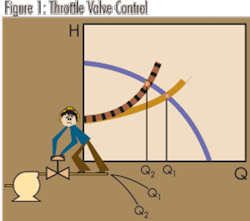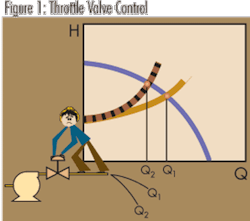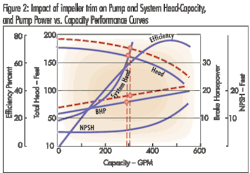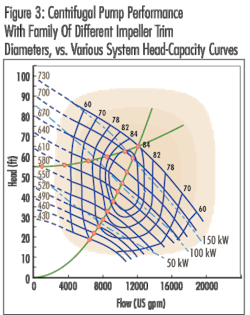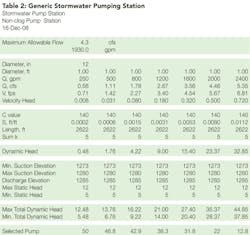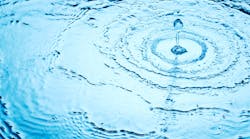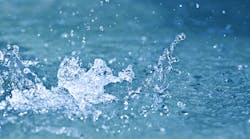By Allan R. Budris
I recently received a basic question about which is more efficient, to throttle a valve or to trim an impeller on a centrifugal pump application. While the answer seems quite obvious to me, trimming an impeller is much more energy efficient then throttling a discharge valve for lower desired pump performance, it apparently is not obvious to all of my readers, so I will elaborate.
When a pump is controlled by a throttle valve, any throttling will increase the system friction head, which pushes the pump back on its Head-Capacity curve, as shown in figure 1. Now since power curves for most industrial pumps (with the exception of higher specific speed pumps over Ns values of about 3,500), decrease with reducing flow rates (see figure 2), the power draw of most pumps will decrease somewhat as the pump is throttled. However, with higher specific speed pumps the power curves actually increase with reduced flow rates, so throttling of these pumps actually increases the power draw.
On the other hand, when a centrifugal pump impeller is trimmed to a smaller diameter the power draw decreases both from the decreasing "power vs. capacity" curve as described above for valve throttling, plus from the much larger impact of the "Affinity Laws", which are as below:
This means that the power draw decreases by the third power of the impeller outer diameter reduction. So a 10% diameter reduction (19% head reduction) would result in a 27% reduction in the power draw, plus any reduction from the lower percent flow rate. This is the same impact as pump speed, which can, however, be varied during operation.
The issue then becomes, how much should the impeller diameter be trimmed for a given application, for maximum energy savings, without jeopardizing the pump's ability to meet the maximum system flow objective. A pump can only have one impeller diameter at a time. However, a replacement impeller with the necessary reduced diameter may always be ordered from the pump manufacturer, while the original impeller is then stored for future use if system friction losses are ultimately increased over time, or if greater capacities are ever required.
The specific steps that should be followed in determining the proper impeller trim selection are:
- Determining the maximum current system flow demand, including a small safety margin, should be the first step in calculating the new (smaller) impeller trim.
- Second, the as-new (pump manufacturer's factory) pump head-capacity and power vs. capacity (flow rate) curves should be obtained. This can be used to determine if the pump performance has degraded over time from internal wear or corrosion.
- Obtain the factory (price book) performance curve which shows the pump family of impeller diameters (see figure 3). This is quite useful in selecting the new desired impeller trim, for a different performance requirement. However, it cannot be used blindly, if the current pump performance has deteriorated from the as-new condition.
- The current actual pump head-capacity and power vs. capacity curves must be determined for an accurate impeller trim. A field test should be performed, if at all possible, to obtain this information, using calibrated instruments (see January 2009 column).
- The impeller diameter family curve can be used to determine how the actual pump performance deviates from the "Affinity Laws" shown above for head and flow, as generally indicated in figure 4. The affinity laws can usually be used up to an impeller trim of 95%, as accepted by the Hydraulic Institute. However, as the impeller is trimmed to lower diameters, a mismatch develops between an impeller and casing flow areas, which makes the pump less efficient. This is why the maximum efficiency for most pumps occurs at the maximum impeller diameter, unlike shown in figure 3.
- The true maximum current pumping system "Head-Capacity" curve is also a requirement in this process. This can be obtained from the actual current pump head-capacity curve, as pointed out in the writer's January 2009 Column. The pump will always operate at the intersection between the pump and system H-Q curves.
- Finally, if the impeller vane overlap is reduced to less than 15 degrees, due to an impeller trim (see figure 5), the "Suction Energy" should be calculated to insure that this lack of vane overlap does not push the pump into "High or Very High Suction Energy", see October 2008 column.
By following the above steps, the new impeller trim should be able to be selected so that it maximizes energy savings, while not jeopardizing the maximum system flow requirement.
It should be noted that during one large company energy audit conducted by the writer, which identified over $2 million in energy savings, that the option with the greatest payback was typically an impeller trim. Impeller trims were most attractive when the maximum system flow requirement was close to the average flow demand. Energy savings are based on the average flow rate, while the impeller trim diameter must be based on the maximum flow requirement, plus a small margin.
More WaterWorld Current Issue Articles
More WaterWorld Archives Issue Articles
